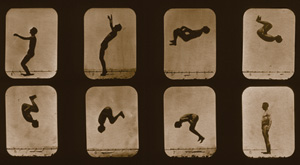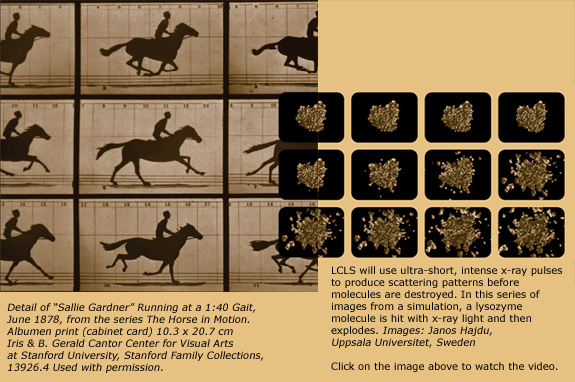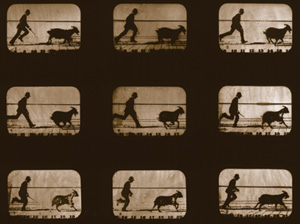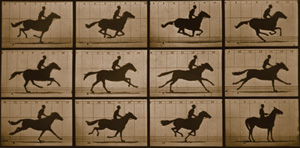X-ray blaze on an invisible world
With laser-precise x-ray vision, the Linac Coherent Light Source will be an unprecedented tool to see how ultra-fast, ultra-small things work.
By Heather Rock Woods
Like Muybridge's fast-shutter photos and Wilhelm Roentgen's discovery of x-rays, LCLS's powerful features promise to revolutionize our view of the world.
The way that a horse trots intrigued Leland Stanford. After a term as California's governor and with a fortune assembled from building the US transcontinental railway, Stanford lived the life of a country gentleman near his Palo Alto Stock Farm. While innovatively training and breeding his famous thoroughbred racers, Stanford challenged the common belief in the late 19th century that when a horse runs, at least one hoof touches the ground at all times to steady and propel it. The debate raged among scientists, artists and horsemen, but the resolution remained a mystery too fast for the eye to perceive.
Determined to settle the issue, Stanford hired photographer Eadweard Muybridge, who specially invented a technique of taking photographs with very short shutter speeds, allowing the first images of fast motion to be taken, in 1878. While one of Stanford's prize trotters raced along a track at 40 feet per second, Muybridge's cameras captured the instant when all four hooves floated above the ground. Stanford enhanced his relatively new reputation as a horseman, and Muybridge helped birth the modern science of motion pictures.
Seventeen years later, in 1895, another scientific advancement also changed the way people viewed the world. Wilhelm Röntgen discovered x-rays and took the first x-ray image–of his wife's hand bones and wedding ring–demonstrating the power to reveal hidden realms.
With a foundation in Muybridge's and Roentgen's advances, imaging technology is entering a new era. A new machine called the Linac Coherent Light Source (LCLS) will be built just up the road from where Stanford's horses once trotted. To capture the rapidly moving, vibrating, rotating, and rearranging world of atoms and molecules, the machine will generate brilliant, breathtakingly short, coherent pulses of x-ray light to freeze moments in time, like a lightning-quick strobe light. Played in series, the images will form a slow-motion movie that illuminates the previously unwatchable.
The machine, to be constructed at Stanford Linear Accelerator Center (SLAC), expects to deliver "first light" to experiments in 2009. The collaboration also includes Argonne National Laboratory, Lawrence Livermore National Laboratory, and the University of California-Los Angeles.
 Athlete, Backwards Somersault, 1879, plate 104 from the series Attitudes of Animals in Motion Printing-out paper print, published by Eadweard Muybridge in 1881 16 x 22.4 cm Special Collections, Stanford University Libraries, RBC.TR140.M93.f.104 Used with permission. |
Molecular movies and more
What are researchers going to do with this unique machine?
"The sky's the limit. There are an enormous number of possibilities," says chemist Kelly Gaffney, assistant professor at Stanford Synchrotron Radiation Laboratory (SSRL).
These possibilities include: learning the structures of bio-molecules vital to drug design and medicine but which cannot be imaged any other way; seeing rapid changes in many kinds of nanomaterials to shed light on computer memory and the failure of structural metals; understanding chemical reactions important to generating clean energy such as hydrogen fuel; and, creating and probing states of matter that mimic the cores of stars.
Gaffney studies photochemistry, the transformation of light energy into chemical energy. Plants use a type of photochemistry–photosynthesis powered by sunlight–to make sugar. LCLS will allow Gaffney to observe the ultra-fast steps, however transitory, in photosynthetic reactions.
"There's a large scientific picture we hope to use LCLS and other tools to understand," he says. "Can you understand how a structure absorbs light energy and generates chemical energy or fuel? Can you make a molecule that is a photocatalyst for the generation of hydrogen gas that can be used as car fuel?"
Gaffney and other scientists using LCLS will make molecular movies of chemical reactions– which occur so swiftly they've never been seen directly before.
|
|
A new type of light
"What LCLS can do is study very small things on a very fast time scale and there's no other way to do it," says Keith Hodgson, director of SSRL. "We're looking to discover new things about materials and techniques to study materials," he adds.
LCLS is a type of machine called a free electron laser (FEL). But as the world's first "hard" x-ray FEL, it will be dramatically different from any laser, or x-ray source, ever built. Hard x-rays are much shorter and more energetic than visible light, and just the right yardstick to measure atoms and bonds between molecules, which are typically one Ångström, or a ten-billionth of a meter.
"It's not an incremental machine advance. It's an astronomical leap," says Phil Bucksbaum, professor of physics at the University of Michigan and a member of LCLS's scientific advisory committee.
Pulses will be 10 billion times brighter and 1000 times shorter than those at today's most powerful x-ray sources, synchrotron light sources. Synchrotrons supply x-ray wavelengths, but not the fleet pulses, coherent light and brightness of LCLS. Ultra-fast lasers–which do provide pulse lengths down to attoseconds (billionths of billionths of seconds)–can't produce x-ray wavelengths, so they can't see the smallest things. Both synchrotrons and ultra-fast lasers are immensely scientifically productive on their own, but LCLS will complement and extend their research capabilities.
LCLS will use a needle-thin beam containing one trillion tightly focused x-rays with the power of 100 million light bulbs. The x-rays will come in pulses lasting only one to a few hundred femtoseconds–millionths of billionths of a second–fast enough to capture a moment of molecular action before it inevitably changes again. Like a laser, the x-rays will be coherent (traveling in phase), which is critical in enabling scientists to gather additional structural information about their samples.
Fast pulses of x-rays are also ideal for probing the inside of matter without disturbing the outside. The extreme intensity of LCLS's x-ray radiation will severely damage matter (unlike relatively benign medical x-rays) but the very fast time scale of the pulses allows the beam, like a nimble cat burglar, to gather the goods and get out before the consequences set in.
To produce the x-ray beam, SLAC will accelerate tiny bunches of electrons to nearly the speed of light in the final kilometer of its existing linear accelerator. The electrons then ride a zigzagging path through undulator magnets, releasing x-rays every time they change direction.
The combination of x-ray wavelengths with laser properties–and femtosecond "shutter speeds"–means LCLS launches a whole new category of research facility that can shine light into previously dark domains.
LCLS is a type of machine called a free electron laser (FEL). But as the world's first "hard" x-ray FEL, it will be dramatically different from any laser, or x-ray source, ever built.
New frontiers for x-ray science
Bucksbaum says there are three main types of start-up experiments:
- experiments to extend the capabilities of existing science tools through a short pulse length and/or short wavelength;
- experiments to characterize and understand this new tool; and,
- experiments to transform existing and nascent fields of science, "the kinds of research that could really transform science and society."
The first category of experiments will propel science forward thanks to the machine's astounding speed and tiny wavelengths, allowing scientists to see fast fluctuations in small things.
One proposed experiment will look at the chemical reactions related to vision that occur at the back of the eye. Other experiments could send shock waves through structural metals and observe the transient processes related to materials failure.
LCLS will finally give Dick Lee, senior scientist at Lawrence Livermore National Laboratory, an experimental way to investigate hot dense matter and create and probe warm dense matter, something no existing source can do. Hot dense matter is in every star and supernova; warm dense matter pervades the cores of large planets like Jupiter and occurs transitionally when a material goes from solid to plasma.
"I'll be able to understand, quantify, and measure states that are extremely hot and dense, reproducibly. That's the charm of LCLS," Lee says. "If you want to understand the cores of planets or the way astrophysical objects radiate, you need to understand in detail so you will get better and better models of how the universe is put together and understand the nature of matter on earth."
|
|
A new light for new science
In the second category, scientists want to know what happens, and how fast, when high intensity x-rays hit matter. Knowing how quickly molecules disintegrate or explode from radiation damage is crucial knowledge for successfully carrying out other experiments.
The intense beam will also create a never-before-studied state of matter: unstable "hollow" atoms stripped of the electrons orbiting closest to the nucleus.
An example of Bucksbaum's third category, transformative experiments, is using a single x-ray pulse to make clear images of large proteins that are bound in cell membranes. These proteins help cells communicate, assist biological materials (including viruses) travel in and out of cells, and offer ways for drugs and other molecules to attach to cells.
Membrane-bound proteins make ideal targets for drug development, which is increasingly based on understanding the structures of target molecules and potential drug compounds.
The single-shot approach would alleviate the usual need to crystallize biological samples before x-raying them, a limitation that has made membrane-bound proteins less accessible to x-ray study than other classes of soluble proteins.
"That's the holy grail, because they are very challenging proteins to crystallize," says Hodgson. "But," he adds, "these will be among the most challenging experiments with LCLS."
|
"The Department of Energy's Office of Science–which funds synchrotron programs–has given the project very high priority and got our full request through Congress. I was euphoric," said SLAC physicist and LCLS Director John Galayda. Congress began funding project engineering and design work for LCLS in fiscal year 2003 with $6 million. Last year, LCLS received $7.5 million for engineering and design, and $2 million for research and development. The big step up to $54 million marks the first phase of construction. Actual groundbreaking and construction of new buildings will begin in 2006. Construction will include half a mile of tunnel and 100,000 square feet of work space, including underground experimental halls and a central laboratory office support building. More than $300 million will be saved by using the final kilometer of the existing 3-kilometer linear accelerator at SLAC. |
Light sources for the future
Scientists are hopeful that these experiments are just the beginning.
There is little doubt that LCLS will eventually make significant leaps in applied sciences, just like the synchrotron light sources that started as basic research programs and are now workhorses for drug development, environmental clean up, and computing advances. However, some scientists are looking beyond the known applications.
"Because LCLS is unique, it has the potential to do the unexpected. The excitement for me is the discovery potential," says Jerry Hastings, SSRL assistant director for LCLS Science.
The excitement is not limited to the United States–several other countries are also working on x-ray free electron lasers. A European collaboration, led by the German Federal Ministry of Education and Research, will build a new facility at Deutsches Elektronen-Synchrotron (DESY). There is also a significant and growing interest in building an x-ray FEL in Japan.
X-ray science, headlined by LCLS, is clearly an expanding, important component of SLAC. Stanford University, SLAC, and SSRL are collaborating on a new center for ultra-fast science that includes LCLS research. In fact, the San Francisco Bay Area has long been a breeding ground for ultra-fast science, from lasers to synchrotrons to ultra-fast physics and chemistry.
In some ways, this work all started when Muybridge photographed trotting horses at Stanford's Palo Alto horse farm. And, like Muybridge's fast-shutter photos and Wilhelm Röntgen's discovery of x-rays, LCLS's powerful features promise to revolutionize our view of the world.
Click here to download the pdf version of this article.




 Goat Running, Chased by Man Wielding Stick, 1879,
Goat Running, Chased by Man Wielding Stick, 1879, "Sallie Gardner" Running at a 1:40 Gait, June 1878, from the series The Horse in Motion. Albumen print (cabinet card) 10.3 x 20.7 cm Iris & B. Gerald Cantor Center for Visual Arts at Stanford University, Stanford Family Collections, 13926.4 Used with permission.
"Sallie Gardner" Running at a 1:40 Gait, June 1878, from the series The Horse in Motion. Albumen print (cabinet card) 10.3 x 20.7 cm Iris & B. Gerald Cantor Center for Visual Arts at Stanford University, Stanford Family Collections, 13926.4 Used with permission.


